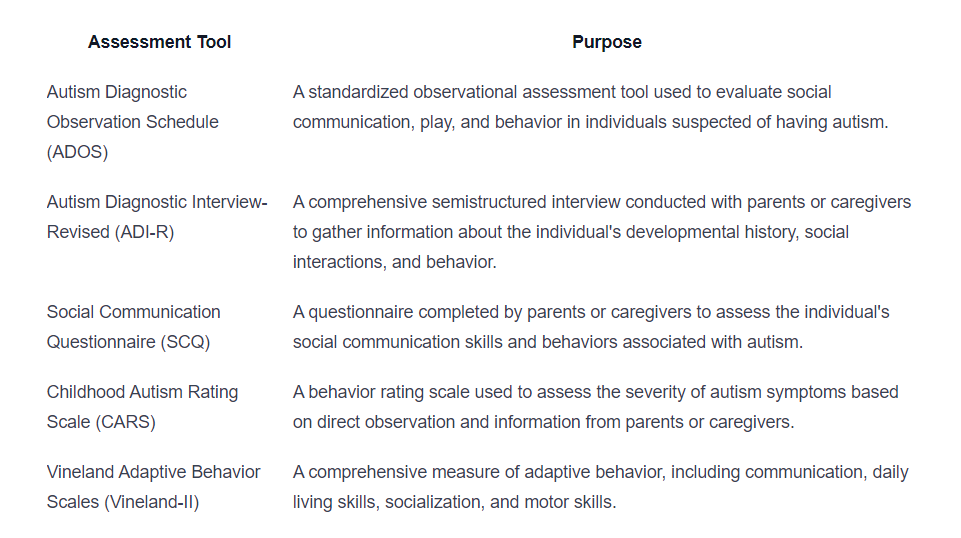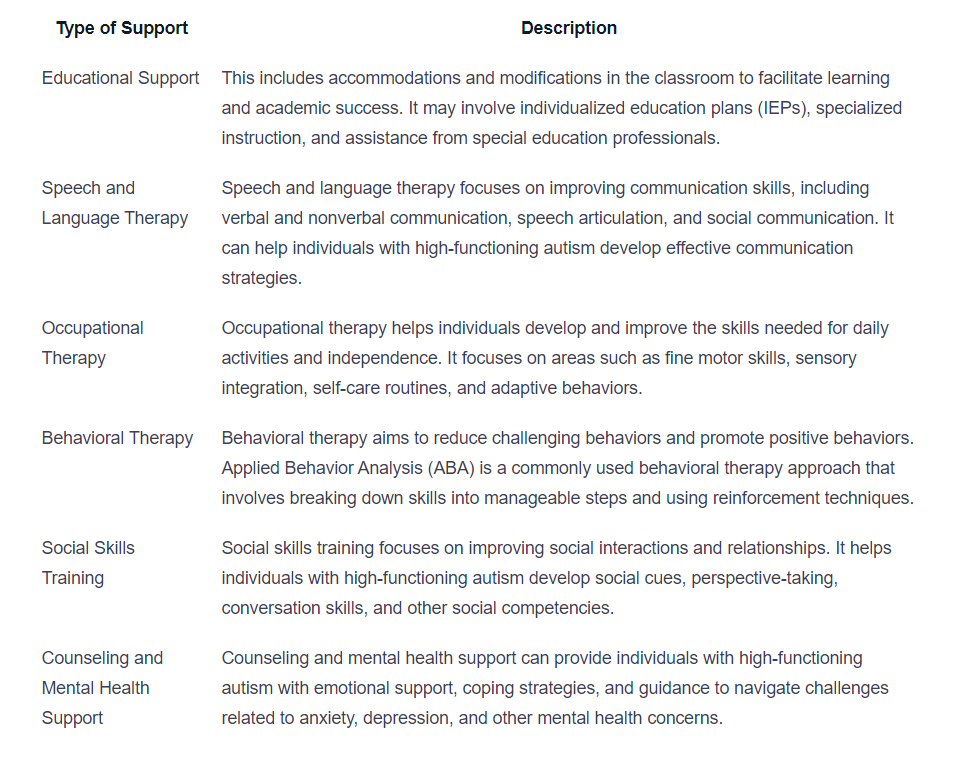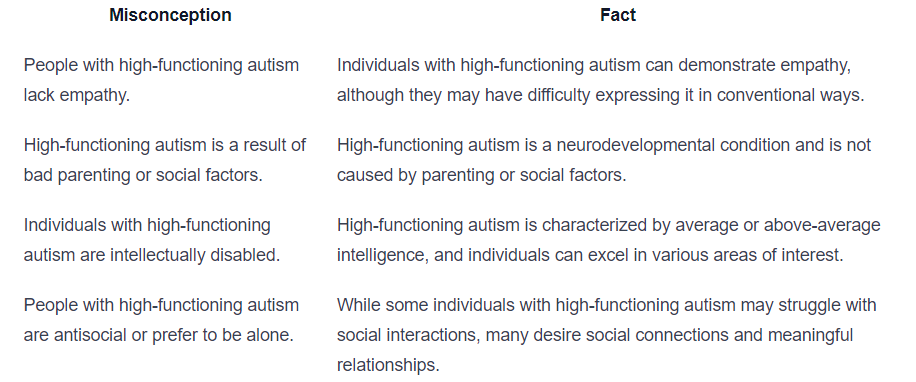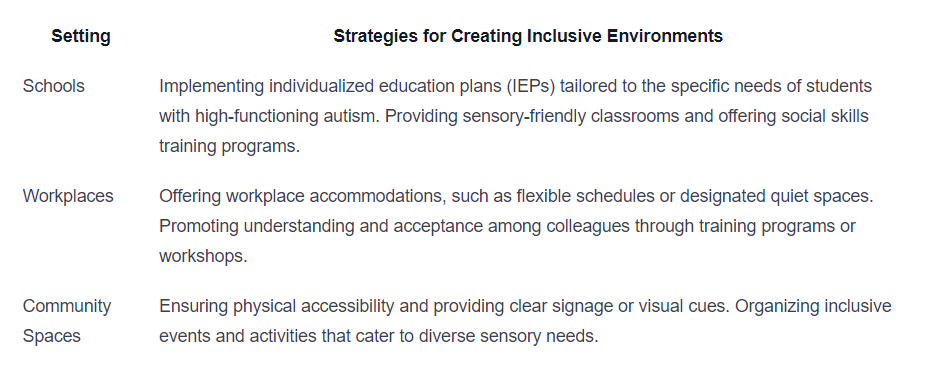High-Functioning Autism': What to Know
Discover the truth about high-functioning autism: characteristics, strengths, support, and acceptance. Get the knowledge you need to understand and embrace.

Understanding High-Functioning Autism
High-functioning autism is a term used to describe individuals on the autism spectrum who have average or above-average intellectual abilities and relatively mild impairments in their communication and social skills. It is important to note that autism is a spectrum disorder, and individuals with high-functioning autism can have a wide range of strengths, challenges, and abilities.

What is High-Functioning Autism?
High-functioning autism, also known as Level 1 autism in the DSM-5 (Diagnostic and Statistical Manual of Mental Disorders), is characterized by persistent deficits in social communication and interaction, as well as restricted and repetitive patterns of behavior, interests, or activities. However, compared to individuals with other forms of autism, those with high-functioning autism typically have fewer difficulties with language and cognitive skills.
In order to receive a diagnosis of high-functioning autism, individuals must meet the criteria outlined in the DSM-5. These criteria include persistent deficits in social communication and interaction across multiple contexts, as well as restricted, repetitive patterns of behavior, interests, or activities. It is important to consult a qualified healthcare professional for a comprehensive evaluation if you suspect high-functioning autism in yourself or someone else.
Characteristics and Traits
Individuals with high-functioning autism may exhibit a variety of characteristics and traits, which can vary from person to person. Some common characteristics include:
- Difficulty with social interactions: Individuals with high-functioning autism may struggle with understanding social cues, maintaining eye contact, and engaging in reciprocal conversations. They may have difficulty understanding social norms and may appear socially awkward.
- Sensory sensitivities: Many individuals with high-functioning autism have sensory sensitivities, which can make them more sensitive to certain sounds, textures, or lights. This can lead to sensory overload and discomfort.
- Special interests: Individuals with high-functioning autism often have intense and focused interests in specific topics or activities. They may spend a significant amount of time learning and talking about these interests.
- Routines and predictability: Having a structured routine and predictable environment can be important for individuals with high-functioning autism. They may struggle with changes in routine or unexpected events.
- Strong attention to detail: Many individuals with high-functioning autism have excellent attention to detail and may excel in tasks that require precision or accuracy.
It is important to remember that each individual with high-functioning autism is unique, and these characteristics can manifest differently in different people. Understanding these characteristics can help create a more inclusive and supportive environment for individuals with high-functioning autism.
Diagnosis and Assessment
When it comes to high-functioning autism, a proper diagnosis and assessment are essential for understanding and supporting individuals with this neurodevelopmental disorder. In this section, we will explore the process of diagnosing high-functioning autism and the common assessment tools used.
Process of Diagnosing High-Functioning Autism
Diagnosing high-functioning autism involves a comprehensive evaluation conducted by a qualified healthcare professional, such as a psychiatrist, psychologist, or developmental pediatrician. The diagnostic process typically includes the following steps:
- Initial Screening: The healthcare professional will conduct an initial screening to gather information about the individual's developmental history, social communication skills, behavior patterns, and any concerns raised by parents, caregivers, or teachers.
- Diagnostic Interview: A diagnostic interview, often involving the individual and their parents or caregivers, will be conducted to gather detailed information about the individual's symptoms, behavior, and social interactions. This interview may use standardized questionnaires to assess the presence of autism-related traits.
- Observational Assessment: The healthcare professional will observe the individual in different settings to assess their social interactions, communication skills, and behavioral patterns. This may involve structured observations, play-based assessments, or naturalistic observations.
- Medical Evaluation: A medical evaluation may be conducted to rule out any underlying medical conditions that could be contributing to the individual's symptoms. This may include physical examinations, genetic testing, or other medical assessments.
- Diagnostic Criteria: The healthcare professional will use standardized diagnostic criteria, such as the criteria outlined in the Diagnostic and Statistical Manual of Mental Disorders (DSM-5), to determine if the individual meets the criteria for high-functioning autism.
It is important to note that the diagnostic process may vary depending on the healthcare professional and the specific needs of the individual being assessed. Additionally, the process may involve multiple sessions to gather sufficient information for an accurate diagnosis.
Common Assessment Tools
During the diagnostic process, healthcare professionals may utilize various assessment tools to gather information and evaluate the individual's symptoms and functioning. These tools help in assessing different aspects of high-functioning autism, including social communication, behavior, and cognitive abilities. Some common assessment tools include:

These assessment tools, along with clinical judgment and expertise, help healthcare professionals make an accurate diagnosis and develop tailored intervention strategies to support individuals with high-functioning autism.
A thorough diagnosis and assessment process is crucial for individuals with high-functioning autism, as it provides a foundation for understanding their unique strengths, challenges, and support needs. By utilizing standardized assessment tools and a multidisciplinary approach, healthcare professionals can ensure a comprehensive evaluation and develop effective intervention plans.
Challenges and Strengths
Living with high-functioning autism presents unique challenges and strengths for individuals with this condition. Understanding these aspects is crucial in providing support and fostering acceptance.
Challenges Faced by Individuals with High-Functioning Autism
Individuals with high-functioning autism often face various challenges in their daily lives. These challenges may include:
- Social Interactions: Difficulties in understanding social cues, nonverbal communication, and social norms can make it challenging for individuals with high-functioning autism to form and maintain relationships.
- Sensory Sensitivities: Many individuals with high-functioning autism experience sensory sensitivities, such as being hypersensitive to certain sounds, lights, textures, or smells. These sensitivities can lead to sensory overload and contribute to anxiety or discomfort.
- Executive Functioning: Difficulties with executive functioning skills, such as planning, organizing, and managing time, can make it challenging to complete tasks and meet deadlines.
- Emotional Regulation: Managing and expressing emotions can be a struggle for individuals with high-functioning autism. They may experience intense emotions and have difficulty understanding and regulating them.
- Transitions and Changes: Adjusting to transitions and unexpected changes can be particularly challenging for individuals with high-functioning autism. They may rely on routines and predictability to feel more comfortable and secure.
Understanding these challenges can help individuals with high-functioning autism receive the support and accommodations they need to thrive in various aspects of life.
Unique Strengths and Abilities
While individuals with high-functioning autism face challenges, they also possess unique strengths and abilities. These strengths can contribute to their personal growth and success in different areas. Some common strengths may include:
- Attention to Detail: Individuals with high-functioning autism often demonstrate strong attention to detail, focusing on specific elements that others may overlook. This can be advantageous in tasks that require precision and accuracy.
- Strong Memory: Many individuals with high-functioning autism have exceptional memory skills, allowing them to retain and recall vast amounts of information.
- Analytical Thinking: The ability to think analytically and approach problems from different perspectives is a common strength among individuals with high-functioning autism. This can lead to innovative and creative solutions.
- Specialized Interests: Individuals with high-functioning autism often develop intense interests in specific subjects. Their deep knowledge and passion for these interests can lead to expertise in particular areas.
- Honesty and Integrity: Individuals with high-functioning autism tend to value honesty and integrity, often displaying a strong sense of fairness and justice.
Recognizing and nurturing these strengths can empower individuals with high-functioning autism to excel in various domains, such as academics, careers, and personal relationships. By focusing on their strengths, individuals with high-functioning autism can build upon their abilities and lead fulfilling lives.
Support and Interventions
Individuals with high-functioning autism may benefit from various types of support and interventions to help them navigate daily life and reach their full potential. These support systems are designed to provide assistance in areas such as communication, social skills, and emotional well-being. Additionally, therapeutic interventions and strategies are often employed to address specific challenges and promote growth. Let's explore the types of support available and some common therapeutic interventions and strategies used for individuals with high-functioning autism.
Types of Support Available
Support for individuals with high-functioning autism can come in various forms, tailored to address their unique needs. Here are some common types of support available:

Therapeutic Interventions and Strategies
Therapeutic interventions and strategies are an essential part of supporting individuals with high-functioning autism. These interventions are designed to address specific challenges and promote skill development. Here are some common therapeutic interventions and strategies used:

Support and interventions play a crucial role in empowering individuals with high-functioning autism to thrive and lead fulfilling lives. By providing the necessary support and implementing targeted interventions and strategies, we can help individuals with high-functioning autism reach their potential and navigate the world with confidence and success.
Education and Employment
Individuals with high-functioning autism may face unique challenges when it comes to education and employment. However, with the right support and accommodations, they can thrive in these areas. Navigating education systems and transitioning to the workplace require careful consideration and understanding.
Navigating Education Systems
When it comes to education, individuals with high-functioning autism may require specific accommodations to help them succeed in a traditional classroom setting. These accommodations can include:
- Individualized Education Program (IEP): An IEP outlines specific goals, services, and supports tailored to the student's needs. It ensures that their educational experience is individualized and maximizes their potential for learning and development.
- Classroom Modifications: Certain modifications, such as preferential seating, visual aids, and sensory breaks, can create a more inclusive and supportive learning environment for individuals with high-functioning autism.
- Social Skills Training: Social skills training programs can help individuals with high-functioning autism navigate social interactions and develop appropriate social behaviors.
It is important for educators, parents, and students to communicate and collaborate to ensure that the necessary supports are in place for a successful educational experience.
Transitioning to the Workplace
Transitioning from education to the workplace can be a significant milestone for individuals with high-functioning autism. Some key considerations during this transition include:
- Vocational Training: Vocational training programs can provide individuals with high-functioning autism the necessary skills and knowledge to navigate the workplace. These programs often focus on job-specific skills, workplace etiquette, and social interactions.
- Job Placement Services: Job placement services can assist individuals with high-functioning autism in finding suitable employment opportunities that align with their skills and interests. These services may offer job coaching, resume building, and interview preparation.
- Workplace Accommodations: Employers can make accommodations to create an inclusive and supportive work environment for individuals with high-functioning autism. This can include providing clear instructions, visual aids, and opportunities for regular feedback and communication.
By recognizing the unique strengths and abilities of individuals with high-functioning autism and providing appropriate support and accommodations, they can successfully navigate the education system and transition to meaningful employment. It is essential for society to foster understanding and acceptance, creating inclusive environments that value the contributions of individuals with high-functioning autism.
Understanding and Acceptance
Understanding and acceptance are key components in supporting individuals with high-functioning autism. By promoting understanding and creating inclusive environments, we can foster a sense of belonging and improve the overall well-being of individuals on the autism spectrum.
Promoting Understanding and Acceptance
Promoting understanding and acceptance of high-functioning autism involves educating the general public about the condition and dispelling misconceptions. By increasing awareness and knowledge, we can create a more inclusive society that embraces neurodiversity.

By dispelling these misconceptions and providing accurate information, we can foster empathy, reduce stigma, and create a more inclusive society for individuals with high-functioning autism.
Creating Inclusive Environments
Creating inclusive environments involves making accommodations and adjustments to ensure that individuals with high-functioning autism can fully participate and thrive in various settings, including schools, workplaces, and community spaces.

By implementing these strategies, we can create environments that respect and accommodate the unique needs of individuals with high-functioning autism, enabling them to fully participate and contribute to society.
Understanding and acceptance play vital roles in supporting individuals with high-functioning autism. By promoting understanding and dispelling misconceptions, we can foster empathy and reduce stigma. Additionally, creating inclusive environments through accommodations and adjustments ensures that individuals with high-functioning autism can thrive and participate in various aspects of life. Together, we can build a more inclusive and accepting society for everyone.
Sources
https://www.thrivingwellnesscenter.com/blog/highfunctioningautismchecklist
https://www.webmd.com/brain/autism/high-functioning-autism
https://www.healthline.com/health/high-functioning-autism
Similar articles
We’re here to help you

Our team is here to assist you in this process. Contact us for any assistance.
it’s easy to apply
We Accept Most Insurances
Our in-network insurance partnerships make ABA therapy more accessible to families throughout our service areas.







Our Insurance Process
We'll request your insurance details to help us verify your plan's coverage for ABA therapy. Once we've received this information, we'll walk you through your benefits, including copayments, deductibles and out-of-pocket maximums, so you know what to expect in advance.
Our team will then handle the preauthorization and all the necessary paperwork.
.svg)





















.jpeg)


































.jpeg)




.jpeg)







.jpeg)











.jpeg)
















